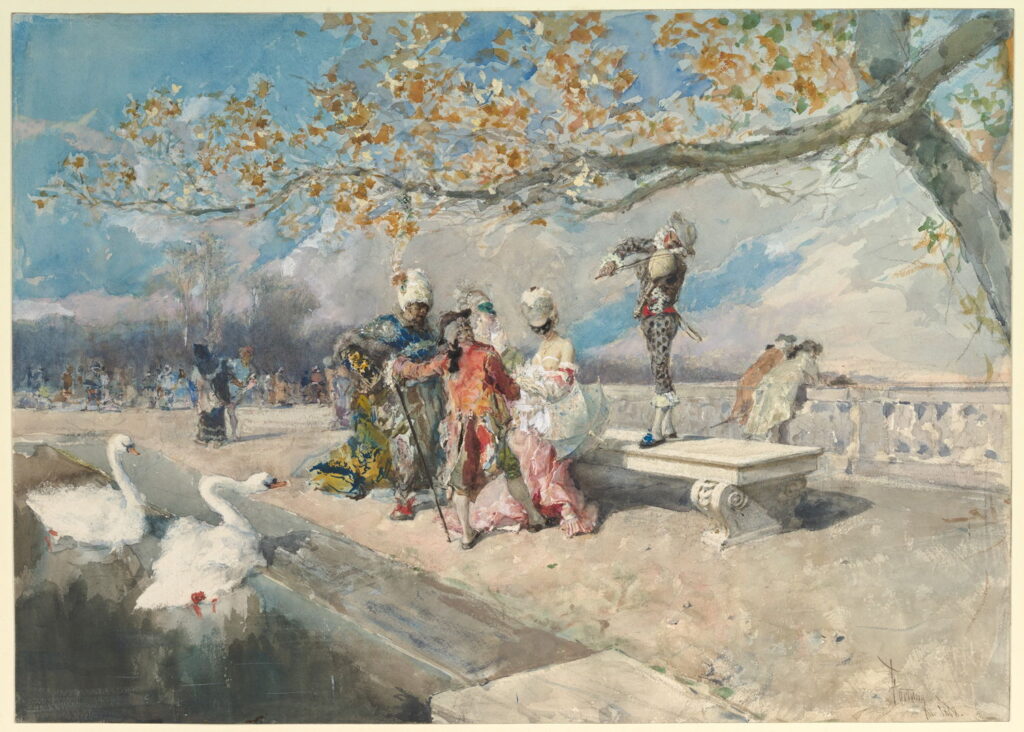Reading visual art: 141 Swan

If you find geese daunting, then what about swans? Although usually seen as graceful if not regal, fully grown adults can weight over 15 kg (33 pounds), and can put up a real fight. They feature in one well-known myth that must have seemed incredible even to the ancients, that of Leda and the swan.
Leda, wife of Tyndareus, King of Sparta, was impregnated by Zeus in the form of a swan, at about the same time that she was also impregnated by her husband. Her twin pregnancies thus resulted in two eggs: one hatched into Castor, who was human because his father was Tyndareus; the other hatched into Polydeuces (Latin Pollux), who was divine as his father was Zeus, and the twins were known as the Dioskuroi.
Unknown follower of Leonardo da Vinci (1452–1519), Leda and the Swan (early 1500s), oil on panel, 131.1 × 76.2 cm, Philadelphia Museum of Art, Philadelphia, PA. Wikimedia Commons.
This interpreted copy of Leonardo da Vinci’s Leda and the Swan, probably painted in the early 1500s and now in the Philadelphia Museum of Art, summarises a later account involving Helen’s unique birth, with two eggs and a fourth baby, Clytemnestra. Later paintings, perhaps wisely, concentrated on Leda and Zeus, and skipped the incredible egg phase altogether.
Jacopo Tintoretto (c 1518-1594), Leda and the Swan (E&I 221) (c 1578-83), oil on canvas, 167 x 221 cm, Galleria degli Uffizi, Florence, Italy. Wikimedia Commons.
Tintoretto and his workshop painted Leda and the Swan in about 1578-83, and wittily include two caged birds, a duck and what appears to be a parrot, with a cat taunting the duck.
Gustave Moreau (1826–1898), Leda (1865-75), oil on canvas, dimensions not known, Musée National Gustave-Moreau, Paris. Wikimedia Commons.
Gustave Moreau started his early Leda in 1865 but abandoned it incomplete in 1875.
Gustave Moreau (1826–1898), Leda and the Swan (c 1882), watercolor and gouache on paper, 34.2 × 22.2 cm, Private collection. Wikimedia Commons.
Moreau’s later watercolour of Leda and the Swan (c 1882) revisits this myth as another static display of female beauty, with the added twist of a large, dark aquiline bird by Leda’s feet. Although this could be an eagle, the bright red at its base suggests the flames of a phoenix just starting to self-combust. This is a curious combination of symbols of self-renewal through cyclical combustion, and a woman who laid eggs.
Joseph Stella (1877–1946), Leda and the Swan (1922), oil on copper, 108 x 118.1 cm, Private collection. The Athenaeum.
Joseph Stella’s Leda and the Swan (1922) follows a more modern tradition.
Jean-Léon Gérôme (1824–1904), Leda and the Swan (1896), oil on canvas, 82.6 x 73.7 cm, Private collection. Image by Rauantiques, via Wikimedia Commons.
Jean-Léon Gérôme’s Leda and the Swan is drawn not from Ovid’s Metamorphoses, but direct from older Greek mythology. He shows over twenty young children, some of them winged amorini, bringing the swan to Leda as she wades into a river.
Swans appear in the supporting cast of some other myths.
After the scorched remains of Phaëthon were buried by Naiads in a distant tomb, his mother Clymene was left to mourn his death. Phaëthon’s lamenting sisters were then transformed into poplar trees, and their tears into amber (electrum). Phaëthon’s beloved friend Cycnus was transformed into a swan who shuns the heat by taking to the water that extinguishes fire. His name lives on in the genus to which swans belong, Cygnus.
Santi di Tito (1536–1603) The Sisters of Phaethon Transformed into Poplars (c 1570), fresco, dimensions not known, Palazzo Vecchio, Musei Civici Fiorentini, Florence. Wikimedia Commons.
Santi di Tito’s fresco of The Sisters of Phaethon Transformed into Poplars, from about 1570, shows the four young women with leaves sprouting from their hands and heads, as they lament the death of their brother. A swan makes a cameo appearance in the foreground, referring to the transformation of Cycnus.
The chariot of Venus is sometimes described as being drawn by white swans, as shown in Antoine Coypel’s painting of The Alliance of Bacchus and Cupid from about 1702, below.
Antoine Coypel (1661–1722), The Alliance of Bacchus and Cupid (c 1702), oil on canvas, dimensions not known, Dallas Museum of Art, Dallas, Texas. Wikimedia Commons.
Swans have also made the occasional transfer into modern legend, including that of King Arthur.
Newell Convers (N. C.) Wyeth (1882–1945), “And when they came to the sword that the hand held, King Arthur took it up.” (1922), illustration p 16 of ‘The Boy’s King Arthur’, ed. Sidney Lanier, Charles Scribner’s Sons, New York. Wikimedia Commons.
N. C. Wyeth’s illustration from 1922 accompanies the text “And when they came to the sword that the hand held, King Arthur took it up.” As three swans fly low behind them, Arthur and Merlin approach the hand in the lake that is presenting Arthur with his sword.
Other mythical themes have been attended by swans.
Gustave Moreau (1826–1898), Hesiod and the Muses (1860), oil on canvas, 155 × 236 cm, Musée National Gustave-Moreau, Paris. Wikimedia Commons.
The association between Pegasus and the Muses was revived in one of Gustave Moreau’s ‘new’ history paintings, of Hesiod and the Muses in 1860. This is the first of a series of works showing Hesiod, generally considered to be the first written poet in the Western tradition to exist as a real person. He is shown to the left of centre, as a young man holding a laurel staff in his right hand. The Muses are squeezed in together, and one is on her knee to present Hesiod with a laurel wreath. There are four swans on the ground, and one in flight above Hesiod, a winged Cupid sat on the left wing of Pegasus, and a brilliant white star directly above the winged horse.
Mikhail Vrubel (1856–1910), The Swan Princess «Царевна-Лебедь» (1900), oil on canvas, dimensions not known, Tretyakov Gallery Государственная Третьяковская галерея, Moscow, Russia. Wikimedia Commons.
In 1896, Mikhail Vrubel met the operatic soprano Nadezhda Zabela, and they married shortly afterwards. His patron invited her to perform in his theatre, and in 1900 she sang in the role of Tsarevna Swan-Bird, or The Swan Princess (1900), in the world première of Rimsky-Korsakov’s Tale of Tsar Saltan, based on the poem of the same name by Pushkin.
Unfortunately, swans have also been consumed by royalty and nobles, in the infamous dish Swan Pie.
Jan Brueghel the Elder (1568–1625) and Peter Paul Rubens (1577–1640), Taste (Allegory of Taste) (1618), oil on panel, 64 × 109 cm, Museo Nacional del Prado, Madrid. Wikimedia Commons.
Jan Brueghel the Elder’s Taste (or Allegory of Taste) (1618), with figures painted by Rubens, is an extensive catalogue of what was then considered to be edible, including a well-prepared swan.
Frans Wouters (1612–1659), Allegory of Taste (1635–59), oil on panel, 56.5 × 89.2 cm, location not known. Wikimedia Commons.
Frans Wouters’ Allegory of Taste was painted in 1635–59, and clearly inspired by Brueghel’s painting. Instead of the lavish jam-packed collation in that earlier work, Wouters seems to have had a smaller budget, or perhaps wished to avoid the sin of gluttony. There is still the infamous Swan Pie on the table.
There are even a few paintings where swans are just swans, including this wonderfully painterly watercolour by Marià Fortuny.
Marià Fortuny (1838–1874), Masquerade (1868), brush and watercolour and gouache over black graphite on off-white heavy paper, 44.9 x 62.9 cm, The Metropolitan Museum of Art (Bequest of Mary Livingston Willard, 1926), New York, NY. Wikimedia Commons.
His Masquerade (1868) shows an open-air masked ball, presumably held in Italy in the autumn, which is arousing the interest or bemusement of two swans. Dress is liberal to say the least, with the woman in the centre baring her breasts while holding a parasol, but she has none of the grace of those swans.



